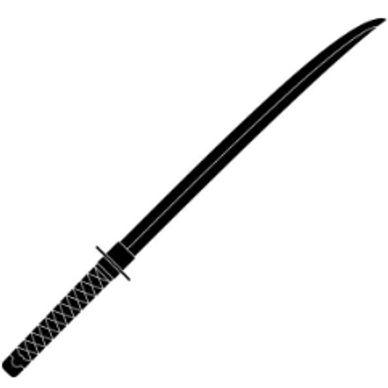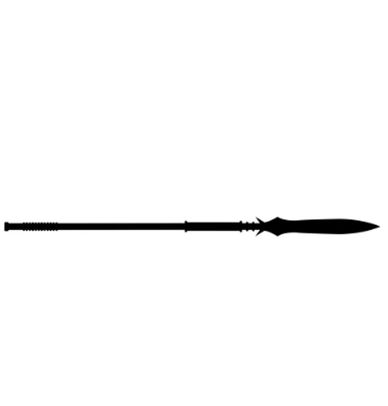season one e-shido weapon style lineup
Katana
Guan Dao (or Kwan Dao)
Guan Dao (or Kwan Dao)

The history of the katana is an evolution of Japanese swords from earlier, straight-bladed designs influenced by China. The curved katana emerged in the late Heian period (around the 1100s) and became prominent after the Mongol invasions of Japan (1274–1281), when the need for a more effective weapon for the rising samurai class became apparent. It was refined during the Kamakura and Muromachi periods, evolving into a symbol of the samurai's authority.
Guan Dao (or Kwan Dao)
Guan Dao (or Kwan Dao)
Guan Dao (or Kwan Dao)

The Guan Dao is a large, heavy, pole-based sword named after the legendary general Guan Yu (died 220 CE). While historical debate continues about whether Guan Yu actually carried such a weapon, the association was cemented in later literature, especially in the classic novel Romance of the Three Kingdoms (14th century). The weapon described in those stories was both awe-inspiring and symbolic, embodying Guan Yu’s strength, loyalty, and sense of justice. Over time, the martial arts community adopted this legendary weapon and it became known as the Kwan Dao.
Nunchuks
Guan Dao (or Kwan Dao)
Longsword

The exact origin of nunchucks is unclear, but they are believed to have originated as an agricultural tool in either China or Okinawa, possibly to thresh rice or as a horse bridle. Later adapted into a weapon in Okinawa, their development as a martial art tool is often linked to a period when the public was banned from owning weapons. They were popularized in the 1970s by martial artist Bruce Lee who showcased them in his films.
Longsword
Longsword
Longsword

The longsword's history is primarily defined by its use in Europe between the late medieval period and the Renaissance, roughly from the mid-14th to the 17th century, evolving from earlier war swords. It was a versatile weapon used in both combat and civilian contexts, and while it became less popular in military use with the rise of firearms and the rapier, it continued to be used for dueling and self-defense.
Gladius
Longsword
Gladius

The gladius is a short, double-edged sword that originated with Iberian tribes and was adopted by the Roman army during the Punic Wars in the 3rd century BCE. Valued for its effectiveness in close-quarters combat, this weapon was a key component of Roman legionaries' arsenal from the 2nd century BCE to the 3rd century AD. Its primary design for stabbing, combined with the scutum shield, allowed Roman soldiers to dominate battlefields through disciplined, close-combat tactics.
Khopesh
Longsword
Gladius

The khopesh is a curved sword that originated in the Bronze Age, appearing in Mesopotamia and Canaan before being adopted in Egypt. It was heavily used during the New Kingdom (c. 1570–1070 BC) as both a military weapon and a symbol of royal power. The design evolved from earlier sickle-shaped weapons and was used for its effectiveness in close combat, allowing warriors to hook and disarm opponents.
Spear
Straight Sword

The history of spear-based martial arts spans millennia, with its origins in prehistoric hunting and warfare. It evolved into diverse systems across cultures, such as Chinese qiang, Sōjutsu in Japan, and Somali style.
Straight Sword
Straight Sword

The history of the straight sword spans ancient times, with early examples from China (the jian) dating back over 2,500 years, and similar straight blades used in ancient Egypt, India, and other regions. Historically, the straight sword evolved from spearheads and was originally used in battle, but its slender, double-edged design made it less effective for heavy combat compared to curved swords. Over time, it became a symbol of status and refinement for scholars and nobles, a ritual object, and a primary weapon in Chinese martial arts like Tai Chi.
Broadsword

The term "broadsword" generally refers to a sword with a broad, double-edged blade that gained prominence in the late medieval and Renaissance periods, evolving from the earlier arming sword. While the broadsword's origins are medieval, the specific term is more accurately applied to Renaissance-era swords, particularly the basket-hilted broadsword, which offered superior hand protection and became a popular military weapon in Europe, especially in Scotland.
Butterfly Swords

Hudiedao or “butterfly swords” are commonly seen in a number of styles of southern Kung Fu including Choy Li Fut, Hung Gar and Wing Chun.
Round Shield
Round Shield

A 19 inch diameter round shield ideal for pairing with the gladius, spear, and khopesh.
This website uses cookies.
We use cookies to analyze website traffic and optimize your website experience. By accepting our use of cookies, your data will be aggregated with all other user data.